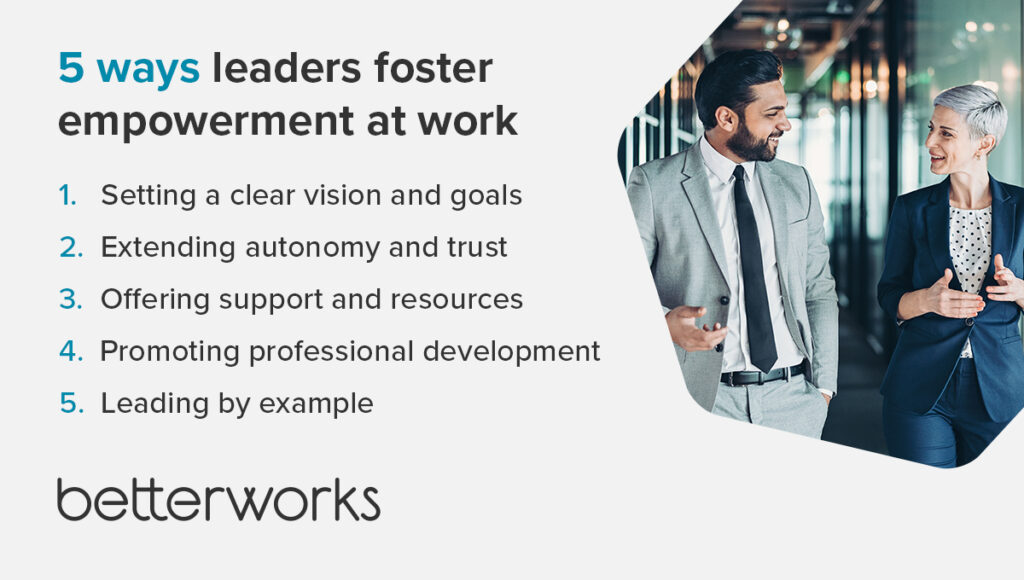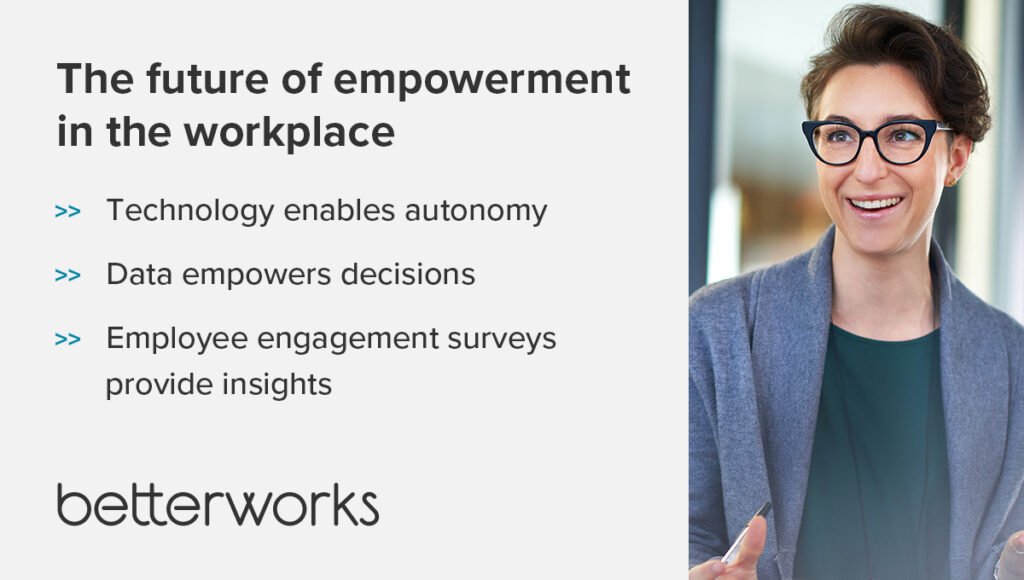Empowerment in the workplace is an increasingly important component of company culture, especially in today’s distributed and hybrid workplaces. Empowered employees are more engaged and motivated, and they contribute to a culture of innovation, collaboration, and high performance.
However, empowering employees isn’t as simple as a few policy changes or buzzwords. Success requires a comprehensive HR approach, leadership support, clear communication, and sufficient resources.
Maximize your workforce’s potential by learning which strategies and best practices will create empowerment at work.
What is workplace empowerment, and why does it matter?
Employee empowerment means giving employees the authority, freedom, and resources to make decisions and take ownership of their work. To do this effectively, workers need the right resources, information, and support.
For instance, employee empowerment can mean letting employees make decisions in their areas of expertise. It also can mean employees who set their own goals, determine when and how they work best, and solve problems independently. Another form of empowerment is giving employees the power to allocate resources — budget, time, and skills — to effectively and efficiently accomplish their tasks.
Empowered employees feel valued, trusted, and motivated to do their best work. That, in turn, promotes higher engagement, enabling team members to take ownership of their tasks, make informed decisions, and actively drive positive change.
3 benefits of employee empowerment for engagement
When employees feel empowered at work, they take charge of their duties and responsibilities, which improves their motivation and job satisfaction. Empowerment also encourages autonomy at work, which contributes to higher employee engagement and a sense of contributing to the organization’s success.
Here are three ways empowerment at work drives higher employee engagement.
Improved employee motivation
Empowerment at work motivates employees by giving them control over their work. This increased autonomy makes them more invested in their tasks, encouraging ownership. The result is a greater sense of purpose and motivation to succeed.
One example of this effect is a customer service team that’s empowered to handle customer complaints via call center software and resolve issues on their own. While customer service agents have scripts, they’re also encouraged to use their judgment and creativity to find solutions. By explicitly trusting them, these employees feel valued and motivated to deliver. As a result, they’re more engaged in their work, seek to improve customer service, and find unique solutions to problems.
Stronger job performance
Front-line employees often have the best sense of how to drive performance in their job roles. Giving them the authority to make small changes to how they work or to suggest process changes can encourage better engagement and long-term performance.
For example, companies can empower salespeople to negotiate and customize deals based on customer needs. With this structured freedom, salespeople can find creative solutions that align with business goals. The result is more deals closed and higher revenue. Because empowered employees feel accountability, they’re also more likely to be productive and hit their role-specific targets.
Higher job satisfaction and commitment
Empowering employees fosters ownership and control, resulting in increased job satisfaction — and a better employee experience. When team members feel like they’ve made a distinct contribution to the organization, they’re more likely to feel personally fulfilled.
For example, employers can increase job satisfaction by creating opportunities for employees to take ownership of projects and meetings. They get to experience a lead role while still having the support and oversight of leaders. This empowerment can increase job satisfaction and loyalty, as they see how they can grow within the organization.
5 ways leaders foster empowerment at work
Leaders empower employees by fostering a supportive and inclusive workplace that helps them take ownership and make decisions. When leaders give workers their trust and the right resources, your teams can achieve even more.
Here are key ways leaders can foster empowerment in the business.
Setting a clear vision and goals
Leaders need to communicate a clear vision and set achievable goals that align with the company’s mission. Doing so gives employees a sense of purpose and reasonable expectations they can stretch to meet.
In a hospital that emphasizes patient-centered care, for example, patients are treated based on their specific needs, not just the generic application of care for their condition. Nurses, doctors, and other staff are empowered to understand each patient’s needs and tailor their approach accordingly.
Extending autonomy and trust
Leaders should trust employees to make in-scope decisions and take ownership of their work. By delegating authority, leaders empower employees to take the initiative and be accountable for their actions.
Autonomy allows employees to showcase their skills, creativity, and problem-solving abilities. They can choose the strategies, tactics, and tools they believe will be most effective in achieving the outcomes they want to see.
The leader can provide support and guidance, along with post-mortems that look at what went well and what could be improved. In an emergency, the leader can even step in. But usually, it’s best to give employees the freedom to make decisions about their work.
Offering support and resources
Part of performance enablement is leaders providing the necessary resources, tools, and training needed to complete their tasks. By offering support and removing obstacles, leaders empower employees to take on challenges in their roles.
For instance, the leader of a software team can empower developers by providing them with the necessary tools, technologies, and training to excel. When they have the resources, these developers can focus on being productive and applying their knowledge.
Promoting professional development
Leaders can support employee growth by providing opportunities for learning and career development. Employees are empowered by the chance to learn, grow, and chart their path forward within the organization.
Mentoring programs are a prime example of helping employees access expertise and career guidance from experienced leaders. While the mentor has responsibilities, mentees are empowered to make the most of the mentoring experience.
Leading by example
Leaders should model the behavior they expect from their employees — including transparency, accountability, and a willingness to take calculated risks.
For instance, sales managers can lead by example by keeping a smaller book, implementing the latest sales techniques, and hitting their targets. By doing the work themselves, leaders inspire employees to do the same.

How to build a culture that champions empowerment
Trust their judgment, and support them in taking ownership of their work. As part of ongoing performance conversations, regularly review and adjust the level of delegation based on individual capabilities and growth.
For instance, managers can delegate project responsibilities, including approvals, to an employee with subject matter expertise. This gives the worker an opportunity to demonstrate their leadership abilities and practice their communication and problem-solving skills.
Recognize and reward empowerment
Employee recognition is important for creating a culture of empowerment, as workers need to know that their work is noticed and appreciated. By sharing success stories and examples of empowered employees, managers reinforce the value of empowerment and encourage workers to continue striving.
Embrace frequent performance feedback
Regular feedback helps employees understand how they’re performing against expectations and how they’re supporting organizational goals. This clarity helps employees focus their efforts and make informed decisions about their work.
By receiving constructive feedback, employees can take ownership of their professional development and seek opportunities to enhance their skills.
Evaluate and adjust
Evaluate the effectiveness of empowerment initiatives and adjust them as needed. Solicit employee feedback from employees, and measure the impact on employee satisfaction, engagement, and performance.
Creating a culture that promotes employee empowerment requires continuous effort. Here are some strategies for building and sustaining empowerment.
Embed empowerment in policies and practices
Empowerment is a lived practice, but it should also be supported by your company policies, practices, and performance management systems. Embed the idea of empowerment into performance evaluations, promotion decisions, and rewards to reinforce its importance.
Flexible work arrangements can be empowering by giving employees control over when and where they work. Flexible work policies demonstrate trust, emphasize results, and can prevent employee burnout. They’re also inclusive of team members who need nontraditional schedules to do their best work and meet their goals.
Define and communicate expectations
Empowerment requires employees to understand their job role’s expectations, responsibilities, and boundaries. Communicate these expectations consistently, and check for understanding.
For example, team members working on a project might be empowered as to how they use existing resources to complete their tasks, but they might need approval to use other tools or to spend money on additional resources.
Delegate authority and autonomy
With expectations set, give employees the authority to make decisions within their areas of expertise. By incorporating employee feedback and performance data, you can evolve empowerment efforts over time.

The future of empowerment in the workplace
Empowerment in the workplace will continue to be important as organizations emphasize employee engagement and use more technology to measure performance. Here’s how technology makes empowerment accessible and efficient — and how tools like Betterworks can help.
Technology enables autonomy
Remote work and digital tools encourage autonomy by enabling employees to access information and make decisions from anywhere and at any time. In organizations that emphasize asynchronous work, autonomy is nonnegotiable. Empowerment is necessary for these companies to perform efficiently. Smart building technology further supports this by automating and streamlining workplace environments, enhancing both productivity and flexibility.
Data empowers decisions
Technology enables organizations to collect and analyze vast amounts of data. This can help employees make smarter decisions with less oversight. Robust data analytics capabilities help employees understand what the data means and where it applies to business problems.
Employee engagement surveys provide insights
Tools like Betterworks employee engagement surveys can improve your organization’s understanding of employee engagement and empowerment. These surveys gather feedback from employees, measure their engagement, and identify areas for improvement. Use these surveys to improve your HR processes and foster a culture of ongoing improvement.

Drive empowerment in the workplace
A sense of empowerment at work is foundational to a successful culture. Empower your workforce to create a highly engaged workforce where employees thrive and reach their full potential.
Want to learn more? Discover the essential elements of employee engagement.








